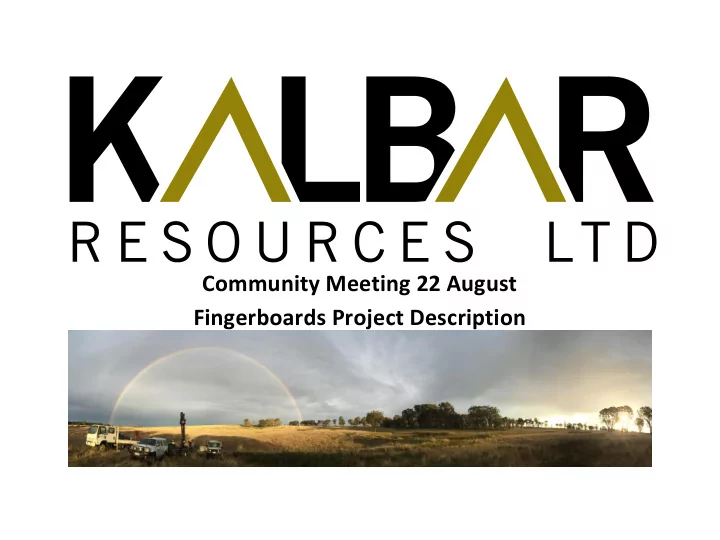

Community Meeting 22 August Fingerboards Project Description
Outline of Presentation This presentation is aimed at providing the following: • Overview of the Fingerboards project description • Mining and processing methods • Rehabilitation and restoration • Water sourcing and management • Required infrastructure • Outline of the footprint in the project area • Outline what changes* have been made to the project • Logistics • Water management • Infrastructure * Changes are shown in blue text in the presentation 2
Project Location 3
Project Area – 1675 hectares 4
Overall Process 5
Mining method • Conventional dry mining operation • Ore slurried to processing plant • Progressive mining sequence • Two mining units and pits will be used after year 1 • Capacity of 1500 tph of ore treatment Soil Conditioning 800m Pasture Re-seeding Topsoil stripping by scraper Topsoil Placement Fines Consolidation using amphiroles Sand Stacking Tailings Free flowing sand dozer Overburden Removal by Excavator 6
Processing method • Conventional wet gravity separation to concentrate the product • Only uses water for mineral separation • Percent solids of fine tailings increased in a thickener • Sand tailings returned to mine void • Fine tailings sent to tailings storage facility (the temporary TSF) Thickener Water Tank Magnetic Circuit Gravity Circuit Feed Tank Screening Plant 7
Rehabilitation and Restoration 8
Rehabilitation and Restoration 9
Mining Layout – first years 10
Water • Water is required for: • Processing of the ore (~ 2.5 GL per year) • Dust management – spraying haul roads using water carts (370 ML per year) • Site ablutions • Offices and workshops • Project will require approximately 3 GL of water per year • Most water lost to: • Seepage from sand tailings • Evaporation from tailings 11
Water Management How will water be managed by Kalbar? Kalbar’s water management plan aims to achieve the following: • Minimise the amount of new water used by: – Maximising water recovered from tailings – Capturing and using rain water falling in mine dams and mine void – Use “mine contact” rain water as process water – If required, managed discharge of treated mine contact water • Minimise the impact on environmental flows to the Mitchell and Perry Rivers – Controlled release of rain water falling on non-mining areas within project area – Prevent uncontrolled release of water from site by using water catchment management dams • Have a positive impact on Mitchell River flow during summer months – Release stored water from site in a controlled manner during summer months 12
Surface Water • Water sourced from the Mitchell River as winterfill take and use licence • Two options considered for off-take locations from the Mitchell River • Water will be stored in a 2.2 GL fresh water dam within the project area • Rain water falling away from mining activities will flow naturally from project area • Rain water falling in catchment that doesn’t come into contact with disturbed land will be released in a controlled manner to the river system • Rain water falling on area disturbed by mining activity will be captured in dams • This water will be re-used as process water • Use of this water will be off-set with fresh water • Areas within the catchment dam footprint is considered as disturbed land 13
Water Management 14
Groundwater - Monitoring 15
Groundwater - Sourcing • Ground water will be used to supplement water requirements • Sourced from the Lower Aquifer (Latrobe Group) • Impact of extraction has been modelled for 15 years at 3 GL per annum • Assessed a large area in the EES for bore field • Cultural Heritage • Biodiversity • Boreholes will disturb a small area of land • Groundwater from bore will be piped to process water dam 2 km 16
Roads – Road re-alignment options 17
Footprint of Disturbance - Hectares Description Old New Topsoil strip 35 35 Overburden strip 23 23 Ore and pit floor 18 18 Course sand tailings and fine tailings cell construction 19 19 Overburden placement 5 5 Topsoil placement 35 35 Mining sub-total 135 135 Fines tailing storage 90 90 Topsoil stockpiles 45 Off path sub-total 90 135 All other infrastructure 55 90 280 360 TOTAL 18
Infrastructure 19
Logistics 20
Rail Sidings - Fernbank • Siding located close to project area on private land • Will utilise a private haulage road from project area • Haulage road aligned with power and water services corridor • Option included in the EES assessments • Traffic • Cultural heritage • Biodiversity • Noise and vibration • Visual • Air quality • Socioeconomic 21
Rail Siding - Bairnsdale • An alternative option is to use the existing siding in Bairnsdale • Concentrate will still be loaded into containers at the mine site • Containers will be trucked to Bairnsdale via Lindenow South (see map below) • Proposed route will avoid traffic along main road in Bairnsdale • Intersection on Princes Highway will be upgraded • Trucks directed around race course to siding • Siding located near Fennings yard will need to be upgraded • Option included in the EES assessments • e.g. traffic, cultural heritage, biodiversity and socioeconomic 22
Enquiries : Victor Hugo - Chief Executive Officer Mobile: +61 408 803 222 Email: victor.hugo@kalbarresources.com.au Kalbar Resources Limited ABN 30 149 545 362 www.kalbarresources.com.au
Section 7 Exemption 24
Recommend
More recommend